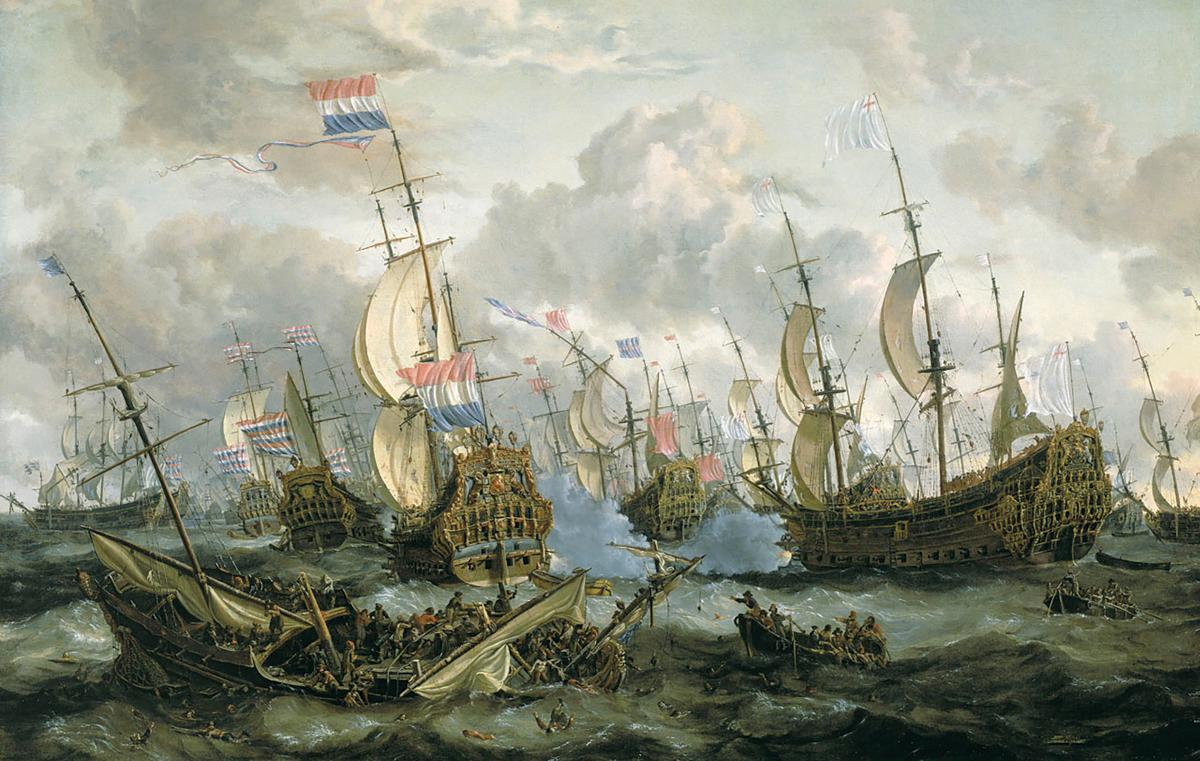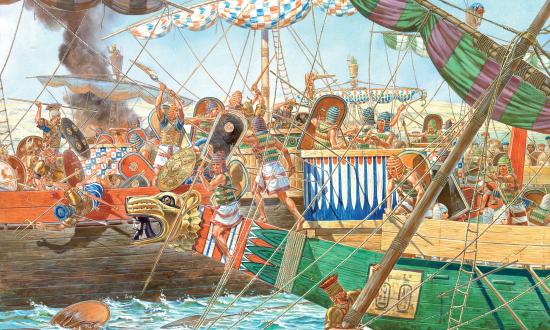Since ancient times, naval battles had been largely a matter of melee and mayhem, of one-on-one ship rammings and brawling deck fights. But the 17th century would see a major advance in the way fleets fought: the line of battle—ships a’sail in single file, pouring broadsides into the enemy. It was a revolution in naval warfare—and it came along as England and Holland vied for dominance of the seas.
The three naval wars waged between these rivals “would be the bloodiest in history,” notes historian Clark G. Reynolds. England had triumphed in the first war (1652–54) and also had won the first round—the June 1665 Battle of Lowestoft—in this, the following clash of the emerging empires. And the fight looming in the spring of 1666 was destined to be, in terms of scale and duration, not only the most epic naval battle of the Second Anglo-Dutch War, or of the century, but of an entire age. The protracted, cannon-blasting slugfest would carry on for four long days. Frank L Fox, whose book on the Four Days’ Battle is the definitive volume on the subject, aptly dubs it “the Greatest Sea Fight of the Age of Sail.”
In January 1666, France had joined as an ally of Holland, and now the French naval threat cast an additional shadow over the English Channel and North Sea. As the English fleet in the Downs prepared to confront the Dutch, word had reached London of a French fleet making its way to join forces with the Dutch. Reacting to this rumor, England’s King Charles II ordered part of the English fleet to split off and make sail for the Isle of Wight to intercept the French. This, in the words of the great British naval historian William Laird Clowes, was the “fatal mistake.”
In the early morning of 1 June, the remaining English fleet under the Duke of Albemarle caught sight of the Dutch fleet under Lieutenant Admiral Michiel de Ruyter off the Flemish coast. Albemarle and his flag officers found themselves facing a mighty warship array—and now, having split their forces, the English were outnumbered.
It was a morning of howling weather and violent waves, and the Dutch had anchored. The English had the wind and moved on the enemy’s rear squadron. Their attack was unexpected amid the foul elements. But the closest Dutch ships managed to get moving before the English ships, unable to bring their biggest guns to bear in the roiling sea, could capitalize on the moment. As the coast of Flanders neared, the English were forced to veer off and soon were being driven seaward through a series of close-range, running cannon duels.
By the end of the first day, both sides had suffered losses, but the English were even more outmatched now. But fight they would. Holding a council of war with his captains, Albemarle declared, “To be overcome is the fortune of war, but to fly is the fashion of cowards.” Throughout the second day, the fleets passed each other in line of battle, back and forth; by the third day, Albemarle’s fleet was reduced further, and a fighting retreat ensued. On the fourth day, sails were sighted—it was the rest of the English fleet, arrived at last from its futile snipe-hunt for the French.
Thus reinforced, Albemarle renewed the fight, both navies tacking westward in parallel, blasting away at each other. Then the Dutch broke through the English center and began pummeling the English with simultaneous windward and leeward broadsides. There was nothing left for Albemarle but to make for England’s shore.
And so ended a sea fight of record-breaking scale—the Dutch coming out a bit the better, but ultimately a draw, with a butcher’s bill on both sides too steep for such a result, and both sides rushing to claim victory. England’s thousands of losses to death or capture included Admiral Sir George Ayscue, whose flagship had run aground. He became (and remains) the most senior English naval officer ever taken prisoner in battle.
Sources:
William Laird Clowes, The Royal Navy: A History from the Earliest Times to 1900, vol. 2 (London: Samson, Lowe, Marston, and Company, 1898), 266–78.
Frank L Fox, The Four Days’ Battle of 1666: The Greatest Sea Fight of the Age of Sail (Yorkshire, UK: Seaforth, 2018), 182–270.
David Howarth, British Sea Power: How Britain Became Sovereign of the Seas (New York: Carroll & Graf, 2003), 216–18.
Clark G. Reynolds, Navies in History (Annapolis, MD: Naval Institute Press, 1998), 50–57.
N. A. M. Rodger, The Command of the Ocean: A Naval History of Great Britain, 1649–1815 (New York: W. W. Norton, 2004), 71–75.





